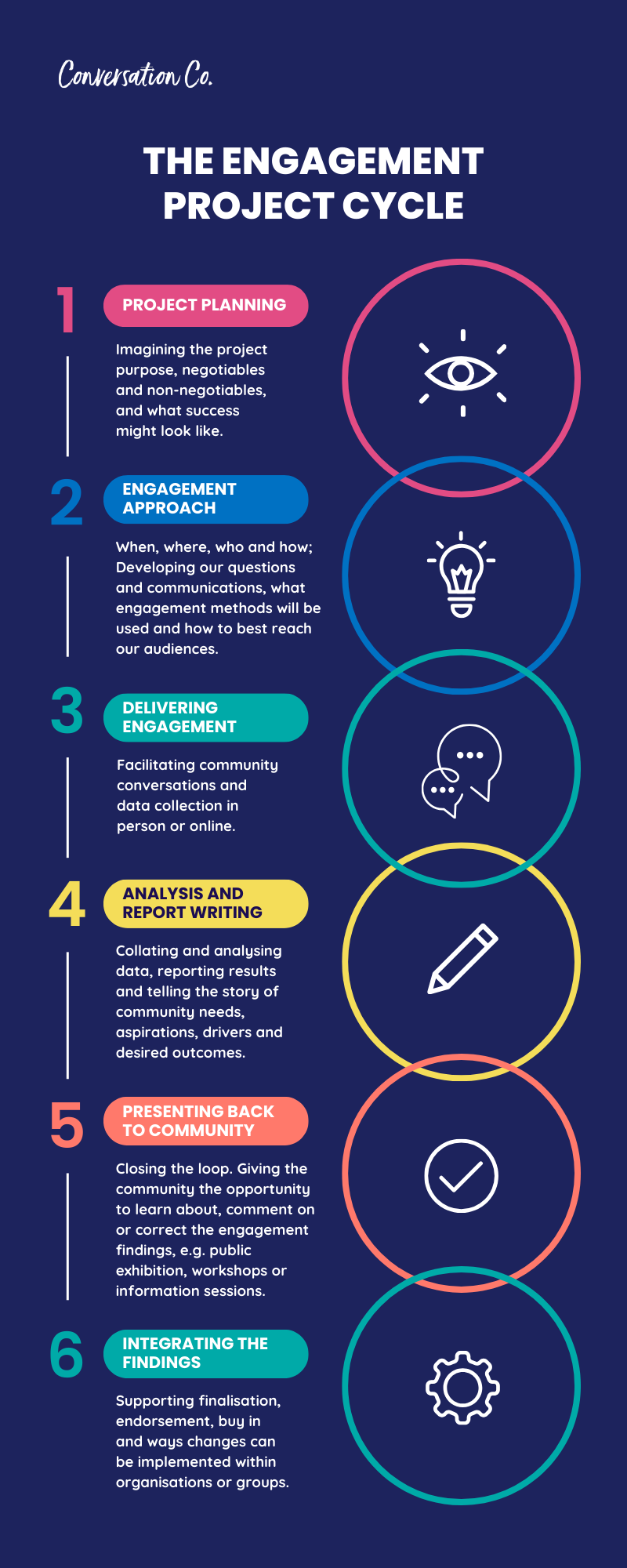How We Scale Up/Down Depending on the Client’s Needs
We can support you through the whole process or you can ‘pick and mix’ specialised support for key moments depending on your project needs.
The Engagement Project Cycle
Here are a few examples of how we can support you and your project depending on your project needs:
The Whole Process: Stages 1-6E.g. Domestic Animal Management Plan (DAMP) working in partnership with 3 Councils:
Project planning including a kick off meeting to understand the negotiables and non-negotiables and understanding the project groups measures of success.
Planning the engagement approach contextualised for each Council, including a communications plan and development of all engagement materials.
Delivering the engagement activities, community pop-ups, stakeholder interviews, online Q&A session and an internal workshop.
Analysis and report writing based on the ten areas of the DAMP.
Development of draft DAMP’s for each Council, with actions developed in the internal workshop.
Supporting the Councils with their Public Exhibition to gain community feedback on the draft DAMP.
Finalisation and endorsement of the DAMP’s based on feedback, including Councillor briefings.
The collaborative approach used in this project not only allowed the Councils to maximise their budget and engagement reach but also provided the opportunity for the animal management teams to network, share resources and develop shared actions for the Domestic Animal Management Plans. Having guidance across the entire project helped to create a sense of ownership and consistency across the many stages.
Pick and Mix: Stages 1 & 2: Brainstorming ideas, purpose and approach. Preparing an engagement plan, communications plan, materials structure for in house engagement delivery. For example developing a plan, runsheets, pop up resources and survey questions for Breathe Easy Gippsland.
Pick and Mix: Stages 3, 5 or 6: We are able to deliver face to face or online engagements at any of these stages tailoring our engagement activities to:
Broad community feedback or needs and aspirations analysis; delivering pop ups, surveys, focus groups. For example running Community Budget voting pop ups for Merri-bek City Council
Closing the loop once the initial engagement is complete; facilitating public exhibitions, workshops or information sessions. For example facilitating discussion with Councillors for the Banyule City Council’s Urban Forest Strategy.
Helping to integrate engagement findings once engagement and reporting are complete; workshops or facilitated discussions with staff, service providers or other teams to discuss findings, future roles and actions for e.g Working with City of Casey staff to implement new Child Safety Standards into their organisation and everyday work.
Pick and Mix: Stage 4: Analysis and Reporting – Bayside Trees Project:Data and background documents are sent to us by the client. This gives us an opportunity to read any reports/policies that are related to the project.
Meeting with the client to establish what the aim of the project is, followed by discussion about what they are anticipating will be themes in the data.
Data analysis of the raw data including coding/tagging.
The write up of the report usually includes a mix of quantitative and qualitative data analysis – tables, graphs and writing presenting the findings. There is usually an evaluation of the project and sometimes we include recommendations.
A draft report is developed and sent to the client for feedback. Depending on the scope of the project, there will be one or more rounds of feedback from the client.
The final reviews will be confirmed on our end and then we will send off a final copy to the client.
Write ups mean we only come in at the end of the project. It allows the clients to conduct their own community engagement such as pop-ups, surveys and focus groups. Our role is to then analyse the data and turn it into a report. Write ups tend to be smaller in scale, meaning there is usually a quick turnaround. It also allows for an independent perspective on the data and analysis to promote efficacy and transparency.



